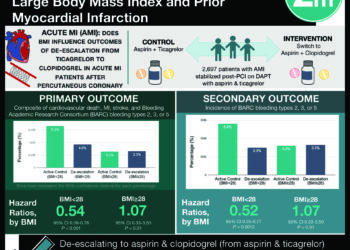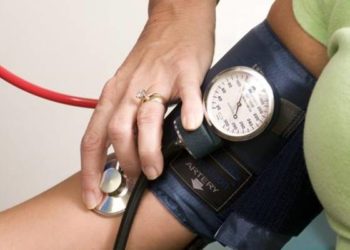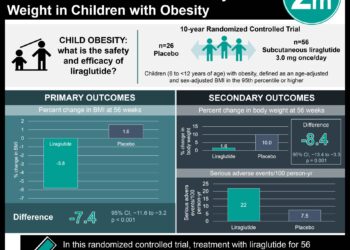The Bogalusa Heart Study: Childhood weight status and cardiovascular risk factors [Pediatrics Classics Series]
Image: PD
1. Children recruited for weight and cardiovascular risk assessment were found to have higher frequencies of cardiac risks factors as their BMIs increased.
2. Among the cardiovascular risk factors assessed, overweight youth had the highest odds of having elevated insulin levels.
Original Date of Publication: June 1999
Study Rundown: The Bogalusa Heart Study was initiated in 1972 in Bogalusa, Louisiana and stands as the longest running biracial study of children, focused on identifying early contributors to coronary artery disease and hypertension. Although being overweight was an established risk factor for multiple adverse health outcomes including insulin abnormalities and blood pressure changes at the time of the investigation, this 1999 study added insight into the connection between early weight risk and cardiovascular health and was one of the first studies to factor sex, race/ethnicity, and age into analysis.
Eleven percent of the 9167 children included in the study were overweight. Cardiac risk factors increased in prevalence as body mass index (BMI, referred to as Quetlet index levels in the paper) went beyond the 85th percentile with considerable risk elevations as BMI increased from the 95th to 97th percentile and beyond. Among the risk factors, overweight youth were found to have the highest odds of having elevated insulin levels. Being overweight was considered an effective screening tool for cardiovascular risk with over 50% of overweight participants having at least 1 risk factor (positive predictive value [PPV] > 50%). Differences between African Americans and whites were noted when examining diastolic blood pressure (DBP) and insulin levels. Low density lipoprotein cholesterol (LDLC), DBP, and systolic blood pressure (SBP) differed significantly between age groups. Tricep skinfold thickness as a surrogate for weight elevation was found to add little to the connection to risk factors when BMI was known. While BMI is a useful surrogate for assessing weight status, it has limited accuracy among certain populations including those with very high or low levels of muscle mass. Despite this limitation, this study produced results agreeing with previous findings and strengthened the evidence to support prevention and early intervention for overweight youth.
Click to read the study in Pediatrics
In-Depth [cross-sectional study]: Nine thousand one hundred sixty-seven children, 5-17 years of age (mean age = 11.9 years; 48% female; 36% black) were drawn from 7 cross-sectional studies completed during 1973-1994 within the larger Bogalusa Heart Study. Age, race/ethnicity, weight, height, triceps and subscapular skinfolds measurements, total cholesterol (TC), triglycerides (TG), LDLC, high-density lipoprotein cholesterol (HDLC), SBP, DBP, and fasting insulin levels were all included in analysis. Logistic regression analyses were completed to assess the association between risk factors and BMI. Eleven percent of study participants were categorized as overweight with a BMI greater than the 95th percentile. As BMI increased, the number of associated risk factors increased. For example, among all children, elevated insulin levels, defined as above the 95th age-, race-, and sex-adjusted percentile, increased from 1% to 27% as BMI increased from 25 to > 97th percentile with the largest increase observed between the increase from 95-97th to > 97th percentile (10% v. 27% among 5-10 year olds, 10% v. 25% among 11-17 year olds, Table 1). The sensitivity of being overweight and having a cardiovascular risk factor varied from 23% for elevated DBP to 62% for elevated insulin levels. The PPV of being overweight also varied from 9% for elevated DBP to 24% for elevated triglycerides (TG > 130mg/dL). The largest calculated odds ratios (ORs) were seen with elevated insulin levels as overweight youth were 12.6 times more likely to have elevated insulin than youth of normal weight (95% CI, Table 2).
Being overweight was considered effective in screening for cardiovascular risk with 61% of overweight 5- to 10-year-olds having at least 1 elevated risk factor and a 58% PPV of being overweight and having cardiovascular risk factors among 11- to 17-year-olds. Significant differences between race/ethnicity were seen between DBP and insulin levels with whites having elevated ORs in both when compared to blacks. As indicated by X2 values above 20.5, elevated LDLC, SBP, and DBP values differed significantly by age group (p < 0.001). Additional analyses indicated that triceps skinfold thickness did not add additional information when BMI was known.
Table 1 Relation of BMI to elevated insulin levels (> 95th percentile)
|
BMI Percentile |
|||||||
|
Age |
< 25 |
25-49 |
50-74 |
74-84 |
85-94 |
95-97 |
> 97 |
| 5-10 years old | 2% | 2% | 3% | 3% | 4% | 20% | 27% |
| 11-17 years old | 1% | 1% | 3% | 2% | 5% | 10% | 25% |
Table 2 Estimated ORs between BMI > 95th percentile and adverse risk factors for all participants (5-17 years old)
|
Risk Factor |
OR (95% CI) |
| TC > 300 mg/dL | 2.4 (2.0-3.0) |
| TG > 130 mg/dL | 7.1 (5.8-8.6) |
| LDLC > 130 mg/dL | 3.0 (2.4-3.6) |
| HDLC < 35 mg/dL | 3.4 (2.8-4.2) |
| Elevated insulin | 12.6 (10-16) |
| Elevated SBP | 4.5 (3.6-5.8) |
| Elevated DBP | 2.4 (1.8-3.0) |
© 2012-2013 2minutemedicine.com. All rights reserved. No works may be reproduced without expressed written consent from 2minutemedicine.com. Disclaimer: We present factual information directly from peer reviewed medical journals. No post should be construed as medical advice and is not intended as such by the authors, editors, staff or by 2minutemedicine.com. PLEASE SEE A HEALTHCARE PROVIDER IN YOUR AREA IF YOU SEEK MEDICAL ADVICE OF ANY SORT.







